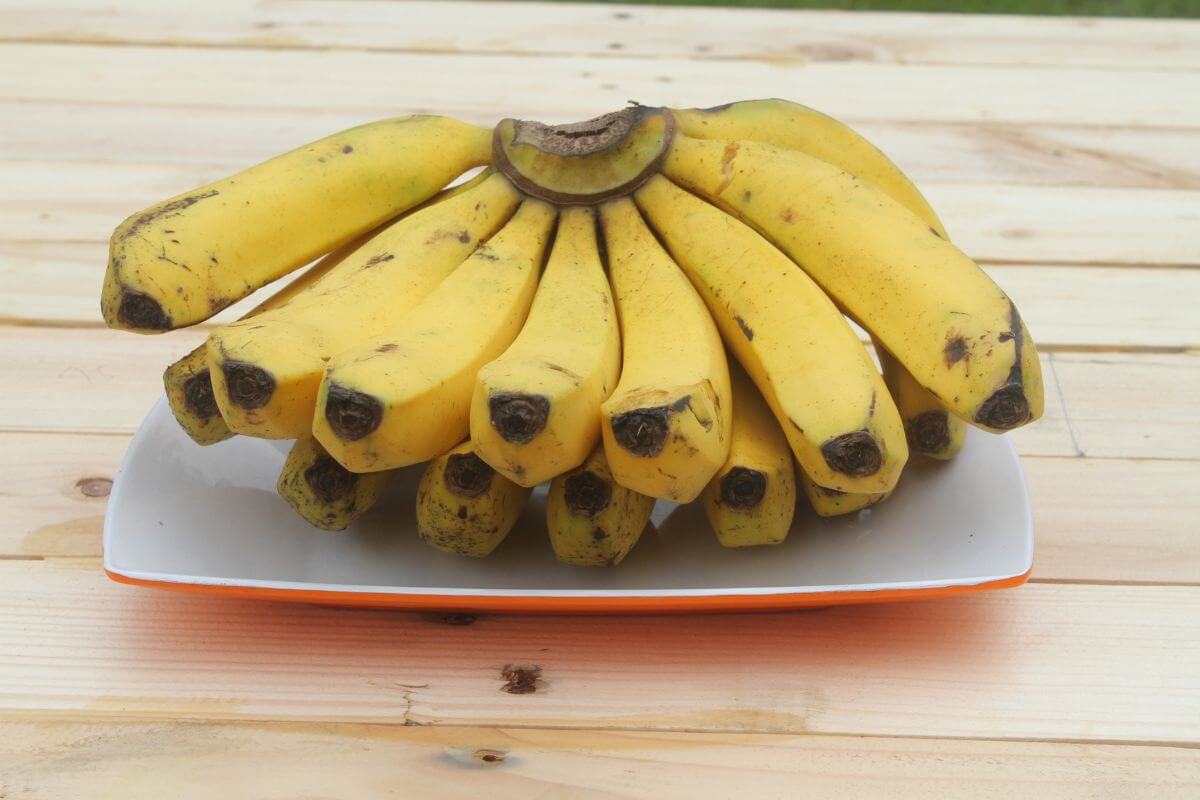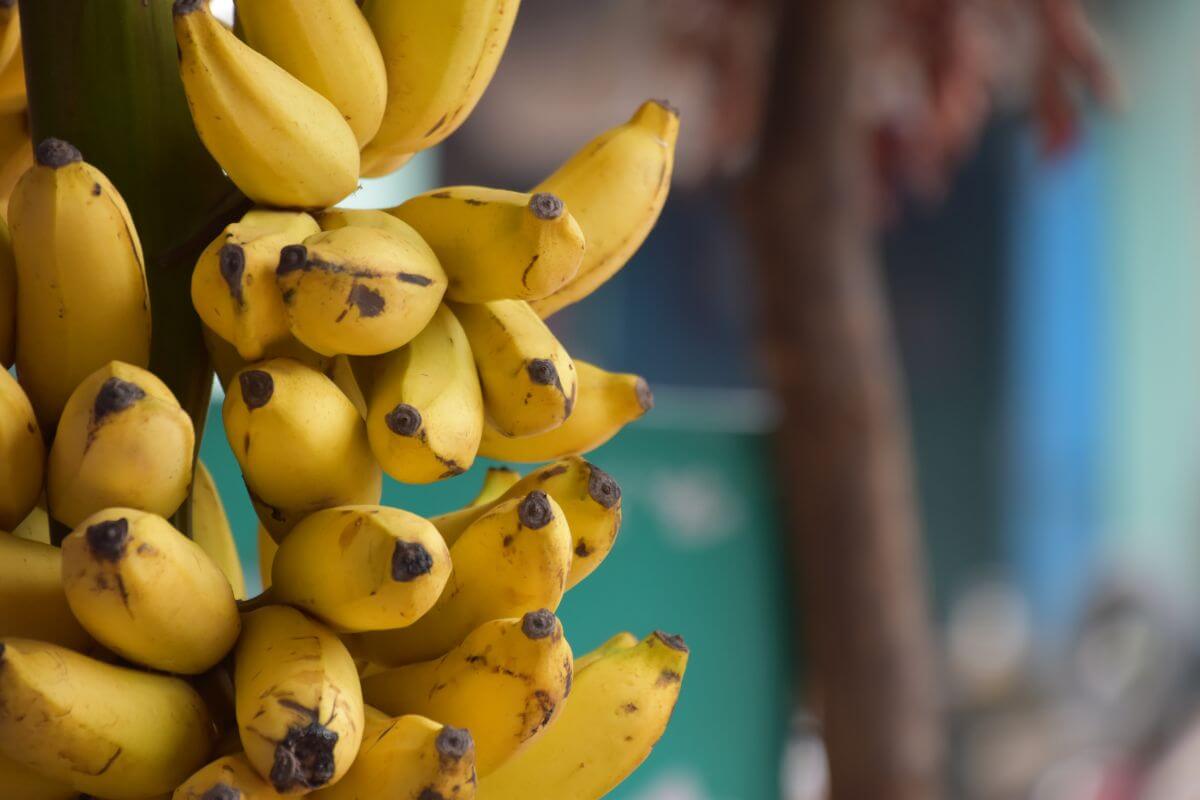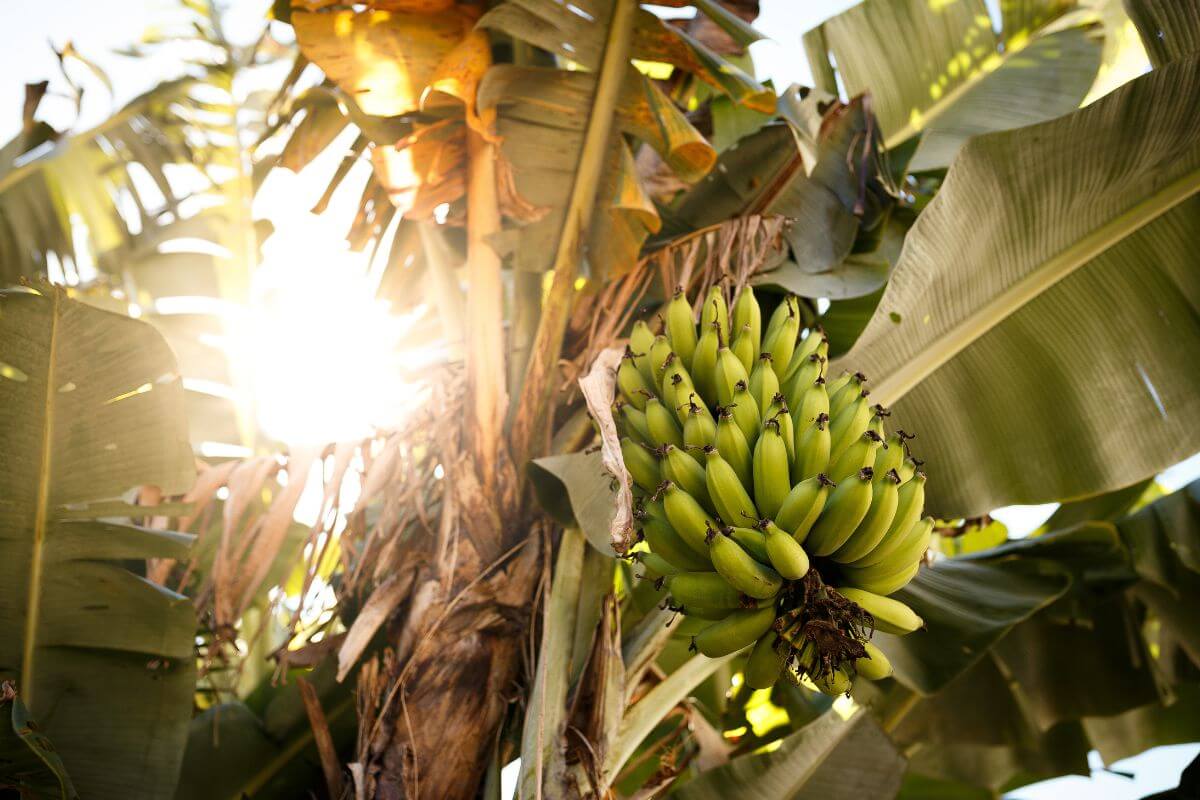Are bananas man-made? The immediate answer would be “no,” they grow on banana trees, which are actually considered herbs and not trees. How could they possibly be man-made?
Depending on your definition of “man-made,” they can very well be considered man-made.
Bananas were not created in a laboratory, and nonetheless, mankind had a hand in today’s banana. If humankind had not intervened in the cultivation of bananas, today’s version would most likely never have been born.
This article will the history of bananas, how they were selectively bred, and why they’re considered man-made.
- Related Article: Common Man-Made Fruits and Vegetables
Are Bananas Man Made?

Bananas are not man made in the sense that they weren’t made in a lab. But bananas are man-made in the sense that they were bred through selective breeding. Today’s bananas are still thought to be the hybrid result of two species of bananas found in the wild: the Musa acuminata and the Musa balbisiana.
Individually, these two wild species are not as appealing as our modern-day banana.
The Musa acuminata has an unpleasant taste, but the fruit inside has a fleshy consistency. Its native habitat is in Southeast Asia.
The Musa balbisiana, on the other hand, tastes good, but has an excessive number of seeds making it unappetizing. It calls Southern China home. This banana’s seeds are large and not really edible, and there are too many. But it does have a useful quality, it is more resistant to diseases.
Banana cultivation or breeding was performed to improve the quality of the fruit and diminish or remove the number of seeds in the wild. Breeding also helped bananas adapt to environmental conditions and changes in different territories.
A Banana genus can be found in Indomalaya or across South and Southeast Asia and Australia. Several wild species can also be found in Papua New Guinea, where numerous varieties are cultivated to this day. There is evidence that bananas have been cultivated there for thousands of years.
These are the ancestors of today’s tasty and nutritious bananas. Modern-day cultivation is challenging in that the modern banana, as a man-made hybrid of the two, is also sterile and cannot be grown from seeds.
- Related article: Are Bananas Fruits or Vegetables?
Banana Hybrids and Sterile
Modern banana plants are clones with very little diversification genetically. There aren’t many varieties of bananas. Because of this, they are susceptible to pests and infections.
Should a new disease find a genetic weakness, it can destroy an entire species of banana . A precedent for this exists in the 1950s with the demise of the Gros Michel dessert banana.
The Gros Michel banana was attacked by a fungus in the soil. Farmers were powerless because they could not breed for disease resistance as the clones were sterile. They couldn’t produce seeds and grow bananas that that would be resistant.
Because the fungus was in the soil bed, there was also no way to remove it and the Gros Michel was left to its demise.
Today’s modern banana is known as the Cavendish, and fortunately, it is more hardy. It resists both infections and insects better, but it does have the same problem as the Gros Michel.
The Cavendish is not a “natural” banana, as it is a hybrid that is the result of years and years of selective breeding. There is little genetic diversification, rendering it vulnerable to diseases.
Banana Selective Breeding

When labeling the banana “man-made,” we are actually referring to a process called “selective breeding.” As in animal breeding, fruit can be bred to improve and obtain specific characteristics. Plant breeding can increase size, taste, and much more.
Selective breeding is used in agriculture to improve agricultural products to be more resistant to pests and infections. It is likewise used to develop a tolerance to harsh climatic conditions.
Selective breeding can use seeds, cuttings, layering, or grafting to grow banana plants. An important aspect of selective breeding is the length of time it takes to produce improved produce. Breeding for a new variety of banana can take centuries and perhaps longer.
Wild bananas usually contain a large number of seeds, and this makes eating them unappealing and difficult to eat. But the seeds in bananas are large enough to grow and use in breeding.
Through selective breeding, the seed size has been successfully reduced, leaving tiny seeds that never mature and are insignificant.
However, it is important to remember that bananas are alo not genetically modified fruit, they are merely a clone of the generation that came before.
Bananas are carbohydrate-rich and contain potassium, phosphorous, vitamin C and B.
Do “Natural” Bananas Exist?
Yes, natural bananas in the wild can still be found in northern and eastern South Asia, as well as Southern China.
There are also hybrid plantain bananas and dessert bananas, a couple types of bananas that are popular. Dessert bananas or Cavendish bananas are sweeter.
A plantain banana is larger, less sweet, and features thicker skin. They tend to have more starch and are usually cooked before being eaten.
How Are Bananas Grown?
Thought to grow on palms, banana plants are actually herbs. The plant is a perennial, that will replace itself by growing from a rhizome or bulb, and not from seed.
Once a bulb has been planted, it will need from nine to twelve months before the fruit can be harvested. Bananas can be cultivated year-round and not limited to a season.
They thrive in the tropics and require rich fertile soil beds with constant moisture in the ground with good drainage as well as in the air.
Can You Grow Bananas at Home?

Banana plants are an extremely popular plant to grow. They have large dramatic leaves that are a great addition to a garden, and add a tropical feel to any space.
Dwarf varieties are available if you don’t have much space, or you want to grow indoors. Miniature banana plants are popular. Getting an edible banana off the plant is a different story though.
To get the banana plant to fruit, the plants need rich, fertile soil, good drainage, steady moisture, and more importantly, temperatures of 80° Fahrenheit during the day and 70°F at night. If you’re lucky enough to live 30 degrees on either side of the equator, then you should have no problem!
In the U.S., bananas will grow outside in Florida and southern California, although the plants may need to be protected if the weather gets too cold.
That being said, there are varieties of banana that will produce fruit if grown indoors. It’s best to stick with dwarf varieties, as banana plants can get a bit large. Although, even dwarf varieties can still grow to 8-10 feet tall.
If you are determined to get a tasty snack from your plant, ensure that you have brought a variety that will definitely bear edible fruit, like the Cavendish Dwarf Banana.
Indoor banana plants can be taken outside during hot weather, but must be kept moist and warm both day and night. They are typically easy to grow and rarely have problems with pests or disease. They can even be grown outdoors in warm climates.
Banana plants can be a great addition to your green family, and look attractive even when they don’t produce fruit. There are many varieties available, from non-fruiting houseplants to large fruiting plants. They are a great ‘tree’ to add to your garden, as they grow very quickly and in the right conditions, produce fruit in less than a year.
How to Grow Bananas from Seeds
Once you do have banana seeds and want to grow them, here are the simple steps on how to grow bananas from seeds.
1. Soak the Banana Seeds
Soak the banana seeds for 24 to 48 hours in warm water. This will soften the seed coat and end the seed dormancy. This will allow the embryos to sprout more quickly.
2. Prepare the Garden Bed
Choose an area of your garden that receives plenty of sunlight. If it’s too cold, you can also start indoors with a seed tray or small container. Add potting soil with plenty of organic compost. The perfect mix would be 40% organic material and 60% sand or airy loam.
3. Plant the Banana Seeds
Sow the banana seeds 1/4 inch deep into the soil and fill with more compost as needed for enouch nutrients.
4. Water the Soil
The soil needs to be moist, but be careful not to overwater and drown the seed. Maintain damp conditions until the seeds germinate.
5. Maintain the Temperature
Maintain temperatures of 60°F or higher. Use heated propagators as even hardy bananas like warm temps. There are some banana trees that can withstand temperature changes and even thrive in only 5 hours of warm temps and 19 hours of cool temperatures.
6. Watch the Banana Seed Germinate
Depending on the variety of banana, it can germinate as quickly as in 2-3 weeks, but other banana breeds can take 2 or more months.
Man-Made Banana Final Thoughts
Today we have numerous species and varieties of bananas in the banana industry. In fact, banana cultivars are thought to number in the hundreds.
Modern varieties of bananas, like the well-known Cavendish, are considered man-made because they are the result of selective breeding.
They have been cultivated to specifically reinforce desirable characteristics. For example, the Cavendish was bred and grown to be a sweet dessert fruit with few to no seeds, and a firm but creamy texture.
Here are other related man-made fruits and vegetables to learn more about:
- Is Broccoli Real?
- Is Cauliflower Man Made?
- Is Corn Man-Made?
- Are Carrots Man-Made?
- Is Asparagus Man-Made?
- Is the Lemon Man Made?
Man-Made Banana FAQs
Do natural bananas still exist?
Natural bananas do still exist, but are rarely found in the wild. However, they are now cultivated in tropical countries around the world. There are 2 main varieties of banana trees: Musa acuminata and Musa balbisiana. Both of these varieties are native to Southeast Asia’s tropical habitats.
Where does a banana come from?
Bananas come from the tropical regions of South and Southeast Asia. Bananas are actually a hybrid between 2 different species of wild bananas from those regions. One species grows in the tropics and the other grows in the subtropics. The hybrids were created when humans brought the seeds back to their home countries.
Do bananas have seeds?
Yes, bananas have seeds, but they are very small and difficult to see in the popular banana variety today. However, wild bananas are filled with large seeds that can be used to propagate. Those large seeds are inedible as well.

